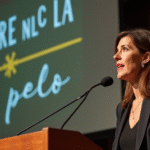Facing Abandonment in Xochimilco’s Chinampas
Nestled within one of the world’s largest cities, a region constituting 59% of its surface area often remains unnoticed: the conservation zone of Mexico City. Within this zone lies Xochimilco, a place that shelters 2% of the world’s biodiversity and is recognized as a UNESCO World Heritage site and Ramsar wetland. However, it faces a silent threat: abandonment.
“It’s said that 60% of the chinampa area is in a state of abandonment,” explains Iliana López Vega, coordinator of the Escuela Campesina (part of the Iniciativa Agroecológica Xochimilco, IAX). “When we talk about abandonment, it means parcels or chinampas that are not being productive in their agricultural nature.”
Escuela Campesina: Cultivating a New Generation of Farmers
In this context, the Escuela Campesina was born. This IAX project aims to cultivate a new generation of farmers, bridging the generational gap where the average age of field workers is between 45 and 60 years old.
From Farmer to Farmer
Javier Ibarra Mesa, an ex-student from the first generation and current coordinator, describes the Escuela Campesina’s work as a deep immersion into the reality of farming. He explains, “Our generation had an eminently practical training, learning directly from native producers. We adapted to their way of life and work, which gave us the strength and resistance to bring this model back to replicate it in the Escuela Campesina.”
The philosophy moves away from conventional agriculture and delves into agroecology, specifically sympatric agriculture. “We seek a model as close to nature as possible, specifically a forest model,” Javier details. This translates into rejecting monocultures and embracing plant consorciales, tree lines, and respect for natural cycles.
Hands-on Restoration
The method is as crucial as the outcome. Soil restoration is “purely manual,” using ancestral tools and avoiding heavy machinery. A central element is the ahuejote, an indigenous tree vital for chinampa structure. It’s used not only to add organic matter through pruning but also to create a “hormonal alert” that accelerates the growth of surrounding plants.
The water from the canals, a delicate resource, isn’t used directly; instead, biofilters ensure riego quality.
New Professions for the Field
While the first generation laid technical groundwork, subsequent generations expanded the vision of what it means to be a farmer today.
“Our group was multidisciplinary,” recalls Ileana, an egresada of the second generation and current coordinator. “There were many agricultural engineers, dancers, industrial administration students.”
“The school showed them that their professions could have an agrarian focus,” Ileana explains.
Broadening the Definition of Farming
“The field isn’t just about planting and harvesting,” Ileana reflects, “but the field can be much more than that—it can be art, it can be design, it’s administration, it can be photography,” she lists. “It can be many things.”
A revealing fact about her generation is that, “of the 25 students who started, only eight were women.” For Ileana, this has profound historical significance. “Women perfected agriculture,” she asserts, “the fact that we, as women, graduated entirely represents that women continue to occupy spaces and are returning to spaces that were once taken from them.”
Her generation focused on recovering space for medicinal plants, believing “medicinal plants heal not only the land but also us.”
Falling in Love with the Roots
The project’s most profound impact may be personal. Gonzalo Contreras, or “Zalo,” is a current-generation student who came to the field due to his grandfather’s memories of farming. For Zalo, working in the chinampa keeps his grandfather’s spirit alive.
“I didn’t like being here in Xochimilco,” Zalo confesses, “due to various silly reasons and my lack of knowledge about the history and importance of my land.” His time at the school completely transformed his perspective. “Being here in the chinampas changed my view entirely, and now I’m in love with Xochimilco.”
Zalo, who dreams of becoming a filmmaker, now envisions combining his passions: dedicating part of his life to agriculture and another to cinematography to tell the chinampa stories.
“If you don’t love what you do, you’ll be unhappy… and I believe I’ve fallen in love with this place, my roots, and everything Xochimilco represents,” Zalo encapsulates the project’s spirit.
In essence, the Escuela Campesina is an act of resistance and hope. It proves that Mexico City’s future food supply doesn’t depend on large technologies but on young individuals like Javier, Ileana, and Zalo who are willing to “get their hands dirty” to “reaffirm the dignity of farm labor.”






